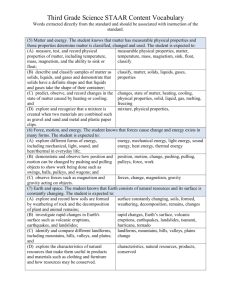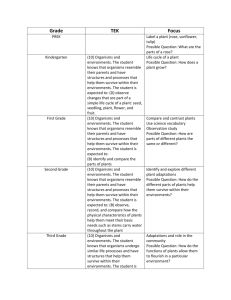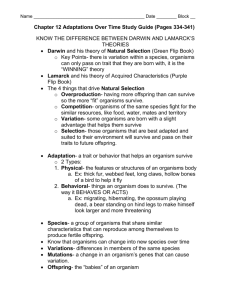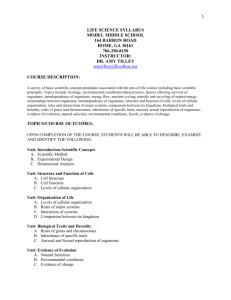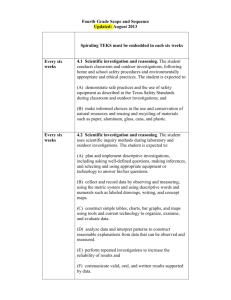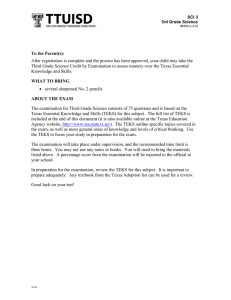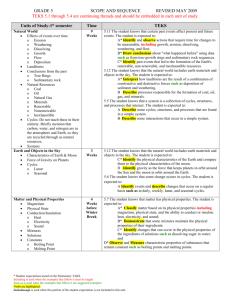First Grade Science STAAR Content Vocabulary Words extracted
advertisement
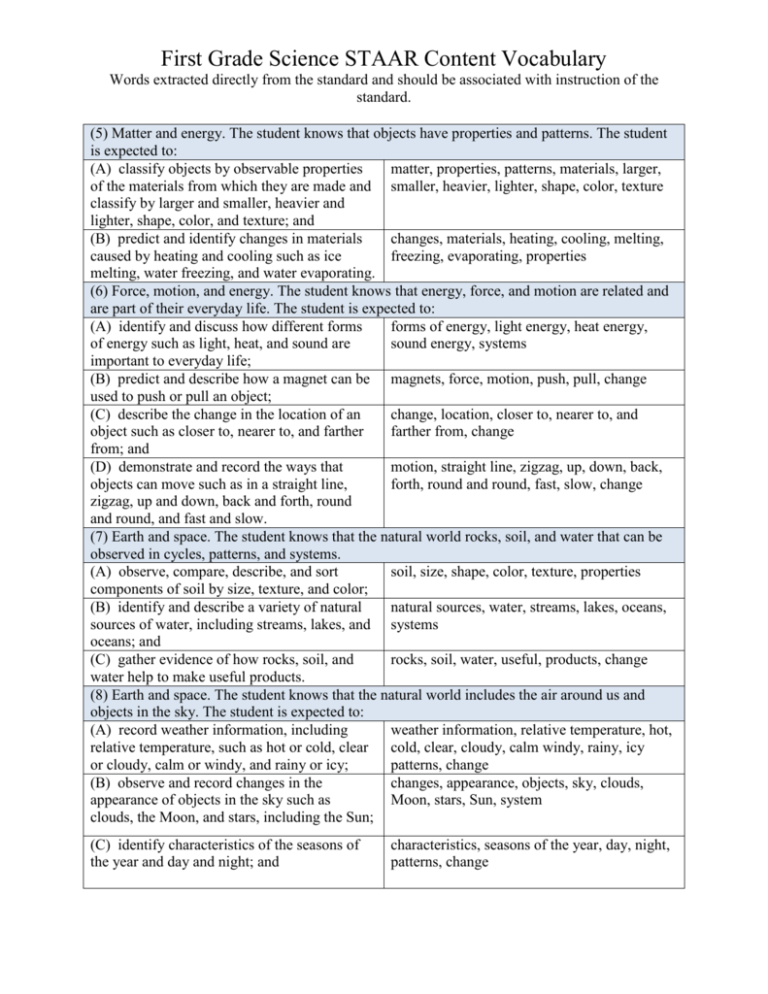
First Grade Science STAAR Content Vocabulary Words extracted directly from the standard and should be associated with instruction of the standard. (5) Matter and energy. The student knows that objects have properties and patterns. The student is expected to: (A) classify objects by observable properties matter, properties, patterns, materials, larger, of the materials from which they are made and smaller, heavier, lighter, shape, color, texture classify by larger and smaller, heavier and lighter, shape, color, and texture; and (B) predict and identify changes in materials changes, materials, heating, cooling, melting, caused by heating and cooling such as ice freezing, evaporating, properties melting, water freezing, and water evaporating. (6) Force, motion, and energy. The student knows that energy, force, and motion are related and are part of their everyday life. The student is expected to: (A) identify and discuss how different forms forms of energy, light energy, heat energy, of energy such as light, heat, and sound are sound energy, systems important to everyday life; (B) predict and describe how a magnet can be magnets, force, motion, push, pull, change used to push or pull an object; (C) describe the change in the location of an change, location, closer to, nearer to, and object such as closer to, nearer to, and farther farther from, change from; and (D) demonstrate and record the ways that motion, straight line, zigzag, up, down, back, objects can move such as in a straight line, forth, round and round, fast, slow, change zigzag, up and down, back and forth, round and round, and fast and slow. (7) Earth and space. The student knows that the natural world rocks, soil, and water that can be observed in cycles, patterns, and systems. (A) observe, compare, describe, and sort soil, size, shape, color, texture, properties components of soil by size, texture, and color; (B) identify and describe a variety of natural natural sources, water, streams, lakes, oceans, sources of water, including streams, lakes, and systems oceans; and (C) gather evidence of how rocks, soil, and rocks, soil, water, useful, products, change water help to make useful products. (8) Earth and space. The student knows that the natural world includes the air around us and objects in the sky. The student is expected to: (A) record weather information, including weather information, relative temperature, hot, relative temperature, such as hot or cold, clear cold, clear, cloudy, calm windy, rainy, icy or cloudy, calm or windy, and rainy or icy; patterns, change (B) observe and record changes in the changes, appearance, objects, sky, clouds, appearance of objects in the sky such as Moon, stars, Sun, system clouds, the Moon, and stars, including the Sun; (C) identify characteristics of the seasons of the year and day and night; and characteristics, seasons of the year, day, night, patterns, change First Grade Science STAAR Content Vocabulary Words extracted directly from the standard and should be associated with instruction of the standard. (D) demonstrate that air is all around us and air, wind, change observe that wind is moving air. (9) Organisms and environments. The student knows that the living environment is composed of relationships between organisms and life cycles that occur. The student is expected to: (A) sort and classify living and nonliving living environment, organisms, living, things based upon whether or not they have nonliving, basic needs, produce, offspring, life basic needs and produce offspring; cycle, system (B) analyze and record examples of interdependence, relationships, system interdependence found in various situations such as terrariums and aquariums or pet and caregiver; and (C) gather evidence of interdependence among interdependence, living organisms, energy living organisms such as energy transfer transfer, food chains, animals, plants, shelter, through food chains and animals using plants relationships, system for shelter. (10) Organisms and environments. The student knows that organisms resemble their parents and have structures and processes that help them survive within their environments. The student is expected to: (A) investigate how the external external characteristics, structures, animals, characteristics of an animal are related to lives, moves, eats, survive, environments, where it lives, how it moves, and what it eats; system (B) identify and compare the parts of plants; plants, structures, survive, environments, system (C) compare ways that young animals animals, resemble, parents, process, cycles resemble their parents; and (D) observe and record life cycles of animals life cycles, processes, survive, animals such as a chicken, frog, or fish. .

